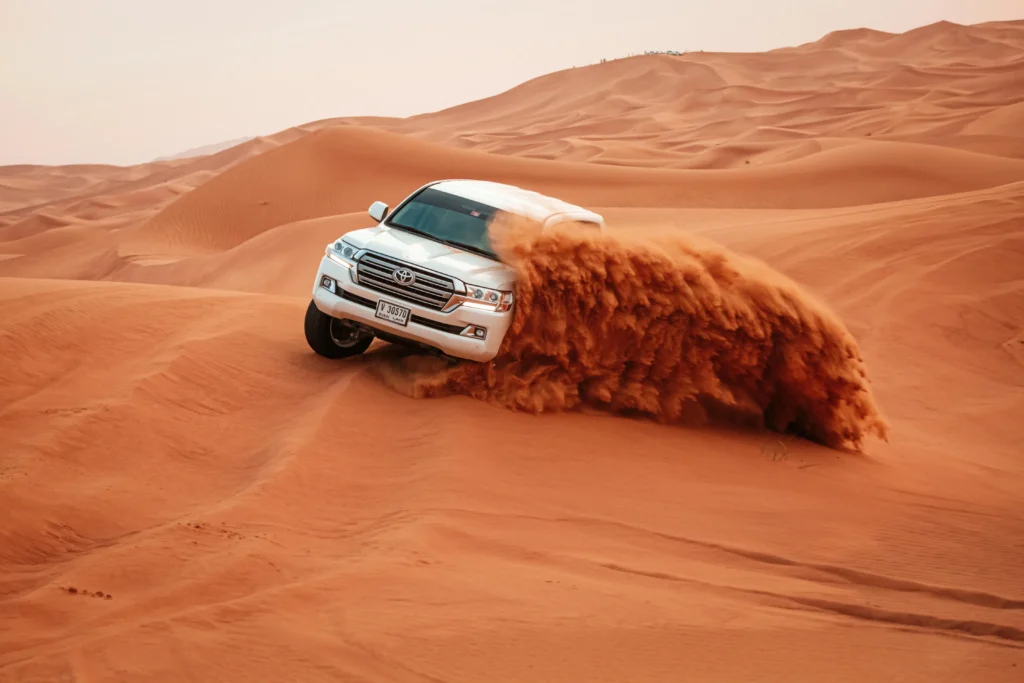
Dubai is a city where every nook and corner exudes meticulous planning, reflecting a marvel of modern architecture. From the large futuristic flyovers to clean highways and well-lit streets with clear signages. Besides, attractions like the Burj Khalifa and tall skyscrapers are visible while driving, which is a further ado.
Just imagine driving in your dream sports car and watching Dubai’s skyline from the Sheikh Zayed Road at a speed of 80-100km/? It sounds heavenly, yet this city has much to explore while driving. Hence, car rentals are a non-resident’s most convenient, affordable, and flexible option.
So, while you are eager to drive your dream car, as the fuel prices are relatively lower than in most other regions, the RTA also has some strict laws. The authorities won’t exempt you even if you are an outsider; hence, tourists need to follow the Dubai driving rules, which will help you avoid trouble.
There are various driving norms and rules for tourists that lead to black points on your license, can levy fines on you, or even criminal cases. Therefore, following the code of conduct mentioned above is essential!
As a tourist, you would opt for a car rental as that’s the most flexible way of exploring the city of Dubai at convenience.
Yet, driving in Dubai as a tourist and with a rental car requires some prerequisites, as given below:
Remember that people with a Work Permit, Study or Spouse Visa, etc, cannot drive with IDP but will need a UAE license. Those worried about minimum age requirements can opt for drivers and chauffeurs.
Before you get behind the wheel, do ensure specific driving rules, a few of which are uncommon in other countries, as given below:
Besides, you can ask your car rental provider for a rear-facing child car seat for customization.
Dubai strictly follows speed limit parameters, so you must be careful while driving.
Therefore, follow the speed limits given below:
These are the general speed limits, but in specific areas, these can vary. Therefore, frequently check for speed limit signs.
Besides, the roads of Dubai are mostly multi-lane and have proper infrastructure. Hence, many tourists find it challenging to drive here.
To cope while driving consistently on these smooth roads, opting for cars with Adaptive Cruise Control helps. Mid-range and luxury cars like Mercedes C200 and Audi A8 have this feature, which automatically adjusts their speed as per the surrounding vehicles. Such deceleration and acceleration helps you drive well, avoiding collisions and distractions.
Moreover, please don’t rely solely on speedometers as they show lesser speed than the actual ones, so the chances of landing in fines can be high. Hence, the ACC helps.
With most of the multi-lane roads in Dubai, the rules are stricter to avoid rash and harsh driving, thus avoiding accidents.
Rental cars like Rolls Royce Ghost Black Badge and Bentley Bentayga S have a Lane Keeping Assist feature, which helps you maintain it. The feature works with cameras that monitor lane markings and the road ahead.
Further, it warns you when switching lanes, and if you don’t respond, it smoothly steers you back to the place to maintain it.
Dubai always expects you to follow a defensive driving approach. Accordingly, the rules for roundabouts and turning have limitations.
No matter where you drive, always give way to ambulances, military convoys, school buses with flashing lights, and similar emergency vehicles. Also, giving way to faster-driving vehicles for your safety will be wiser.
One of the major reasons for accidents while driving is the inability to detect cars in the blind spot. It is more prominent on highways where the probability seems less, but it is not.
Therefore, SUVs with Rolls Royce Cullinan have Blind Spot Monitoring, which detects other vehicles around such areas of your car. Besides, this car has other valuable features, like Night Vision Assist and the ones mentioned above.
Dubai has different parking zones, and you can’t park vehicles in any random location. Therefore, park your car on the roads with yellow and black curb.
Further, to park on the streets, you must pay through the parking meters or mobile apps designated for the purpose. Never park on reserved spots for disabled drivers unless you are not one of them.
Cars with 360-degree surround-view cameras help you park easily without looking here and there, yet creating a mishap. Most of the mid to high range car rentals have the feature.
Planning your routes via the Waze navigation system will be advantageous as a tourist. Even if you don’t see the speed limit boards, the system automatically warns you to change and modify speed.
Additionally, most luxury cars have Traffic Sign Recognition and Heads-Up Displays with Safety Alerts features. These recognize the signboards in Dubai, which might be difficult for a foreigner to recognize otherwise.
Also, the HUD helps you keep your eyes on the road without distraction and even displays safety alerts as necessary. Thus, you can follow all the Dubai driving rules for tourists, even in traffic. Choosing the right car rental will thus make a lot of difference in improving your journey.
Ensure that you always discuss the features you need before renting. Further, double-check whether you meet the eligibility criteria; a chauffeur would help if not.

Phantom Rent a Car are experts in high-quality luxury cars combined with expert service. We help turn your dreams into a reality by providing you with the largest fleet of luxury hire cars to choose from. Our luxury cars allow you to explore everything that Dubai has to offer in style, immersing yourself in the culture, elegance and sophistication of the region.